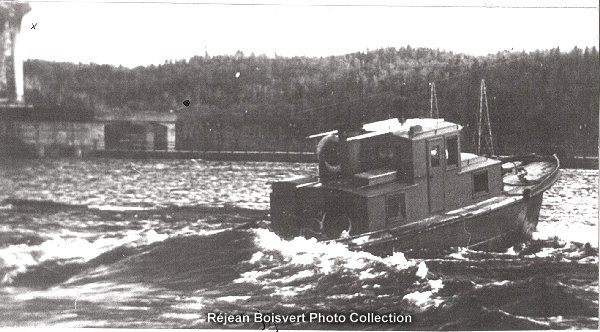|
Russel Brothers Limited OWEN SOUND, ONTARIO Steelcraft Boat Builders
Log Booms were made up of usually three or four 14 inch wide squared off timbers joined together to make a stout perimeter to enclose the logs within. Often, the logging boats would have to enter or leave the boom interior, which was done by just running over the timbers. The boats were constantly bumping around in a sea of logs, and had to be built tough to withstand decades of this sort of abuse. Below, Yves Cloutier recalls what it was like...
Have you ever had the chance to jump a 4 piece boom with a tug?...Look at the photo below and imagine the fun of jumping a boom this size.
Coming full speed ahead, about 300 feet or so in front of the boom, throttle down, line up the tug in the middle of one segment of the boom away from the chains, perpendicular. When the tug hits the boom, full speed ahead. The tug goes halfway out of the water until the tail of the boat clear the boom. Enough to scare anybody unused to this kind of sport!
If you are not going too fast, you can manage to keep the boat on the boom to let some logs escape. Full throttle ahead will make you slide off the boom slowly, with a scary feeling when the back of the boat is about to leave the boom. If you are not square.... get jour life Jacket or close the doors!
Nikauba rests in front of a 4 piece (56 inches wide) log boom, Grande Piles, QC
Boom Jumping: The front of the Rapide Blanc almost completely out of the water after hitting a 42 in. piece of boom. Notice the water coming on the back of the boat....Picture taken at La Trenche Qc., in 1973.
We had also to jump on occasion 4 piece booms (56 in. wide)..... It's recommended to hit square and to push the throttle to the max after the hit if you don't want to get stuck. 
|
Yves Cloutier notes (Nov. 2018):
"Yes Sir! My favorite sport, jumping a 3 piece boom with the tug...
I was never afraid to damage anything on the St-Maurice upper drive, all booms were made of BC Fir 14x14 inches, one, two or 3 pieces wide. Jumping a single or double was routine, a 3 pieces required more caution... normally we were slowing down a bit before the hit and pushing power at the moment of hitting to jump. And yes, we had to hold the wheel tight when jumping a tree piece. 37'6 ft tugs and 40 ft like Amisk were at ease with this business, not the smaller tugs that had to keep to single and double width boom. The feeling of riding in a tight jam was also something!"
https://ingeniumcanada.org/archives/details/X-30311

|
Gord Campbell comments (Jan. 2019): "Bouncing over the booms wasn't exactly the fun part of the job. Not every boat had the same power or ability either. A captain had to know the capability of the boat too. It's why many boats liked to work in pairs. If you managed to get stuck, then the other boat can shake you off the booms.
Jumping the booms is a wee bit of a misnomer. First the official smart procedure is to go to the nearest piling, disconnect the boom, enter or exit the raft then reconnect the boom chains. Well isn't that interesting.
If you look above at the boat, the captain took a long approach. Full power, full speed. and you try to hit the boom perpendicular as possible. The captain liked to see a waterlogged boom since they sank faster and deeper on impact.
Jump the booms. Nope. Try crashing against the boom hoping to drive it deep sliding over it. Its a full crash. The size of the tug counts too. The Martin E. Johnson found it easier than its smaller sister Polygon. With over a thousand horses to spare, the Peninsula would simply push over the booms and more than likely to take out half the raft with it.
It was far easier crossing the booms into the raft. The boat can get to its top speed. Coming out of a raft (logs enclosed by a boom) was a lot more difficult. There is no way a boat can hit full speed in the raft depending on its density.
So boats often got damaged. It was hard on the hulls. You just don't "jump" the booms. You crash into them. And bounce over them. It looks real cool from shore. And while fun like a roller coaster for the crew, they had to hang on like a car hitting a wall at ten miles per hour. If you call that fun. n.b. Gord drove Russel boats in Marathon Ontario. For more on Russel boats used in the Marathon operation, see Marathon ON Logging using Russel Tugs
For more Russel exhibits visit Owen Sound Marine & Rail Museum 1165 1st Ave West, Owen Sound, ON N4K 4K8
(519) 371-3333  http://marinerail.com http://marinerail.com |